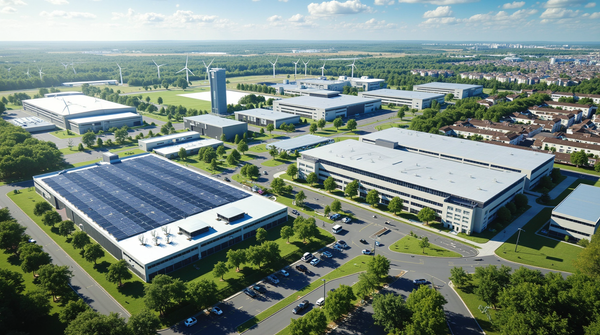"Power-to-X: How Hydrogen is Revolutionizing Large-Scale Energy Storage".

The energy industry is undergoing a major transformation, and hydrogen is at the heart of this revolution. With the emergence of Power-to-X technology, hydrogen offers promising solutions for large-scale energy storage, enabling us to better integrate renewable energy sources and reduce our dependence on fossil fuels. Let's explore how hydrogen is changing the world's energy landscape, and what are the concrete benefits of this technology.
What is Power-to-X?
The term Power-to-X (P2X) refers to a range of technologies for converting electricity into other forms of energy or chemicals, such as hydrogen, methane or synthetic fuels. Among these technologies, Power-to-Hydrogen is particularly promising. Excess electricity generated by renewable sources, such as solar or wind power, is used to electrolyze water and produce hydrogen. This hydrogen can then be stored, transported or used directly as an energy source.
Hydrogen: a versatile energy carrier
Hydrogen is distinguished by its ability to be used in a multitude of ways. As an energy carrier, it can be stored in gaseous or liquid form, transported over long distances and used to generate electricity. For example, hydrogen can power fuel cells in vehicles, offering a clean alternative to internal combustion engines. 🚗💨
What's more, hydrogen can be injected into existing natural gas networks, reducing fossil gas consumption and CO2 emissions. This flexibility makes hydrogen an ideal ally for heavy industry and transport, where direct electrification is often difficult.
Environmental and economic benefits
One of the main advantages of hydrogen is its ability to reduce greenhouse gas emissions. By storing renewable energy in the form of hydrogen, it is possible to smooth out fluctuating renewable energy production and ensure a stable supply of clean electricity. 🌍
On the economic front, the development of hydrogen can stimulate job creation in the engineering, construction and maintenance sectors. Many countries, such as Germany and Japan, are investing heavily in hydrogen infrastructure, hoping to become world leaders in this field.
Concrete application examples
In Denmark, an ambitious project aims to use hydrogen to store surplus energy from offshore wind farms. The project, called HySynergy, calls for the construction of a large-scale hydrogen production facility capable of supplying local industries with energy and vehicle charging stations with hydrogen.
In France, Hynamics is developing hydrogen production solutions to power buses and trucks, thereby reducing particulate and CO2 emissions in urban environments. These initiatives illustrate how hydrogen can be a major asset in the energy transition.
Conclusion
Power-to-X technology, and hydrogen in particular, represents a significant step towards a more sustainable energy future. As a large-scale energy storage solution, hydrogen offers the potential to reduce our carbon footprint while fostering innovation and economic growth. As investment and research multiply, hydrogen could well become one of the pillars of the global energy transition. 💡
By continuing to explore these technologies, we can look forward to a future where energy is not only clean, but also abundant and accessible to all.The energy industry is undergoing a major transformation, and hydrogen is at the heart of this revolution. With the emergence of Power-to-X technology, hydrogen offers promising solutions for large-scale energy storage, enabling us to better integrate renewable energy sources and reduce our dependence on fossil fuels. In this article, we explore how hydrogen is changing the world's energy landscape, and what the concrete benefits of this technology are.
What is Power-to-X?
The term Power-to-X (P2X) refers to a range of technologies for converting electricity into other forms of energy or chemicals, such as hydrogen, methane or synthetic fuels. Among these technologies, Power-to-Hydrogen is particularly promising. Excess electricity generated by renewable sources, such as solar or wind power, is used to electrolyze water and produce hydrogen. This hydrogen can then be stored, transported or used directly as an energy source.
Hydrogen: a versatile energy carrier
Hydrogen is distinguished by its ability to be used in a multitude of ways. As an energy carrier, it can be stored in gaseous or liquid form, transported over long distances and used to generate electricity. For example, hydrogen can power fuel cells in vehicles, offering a clean alternative to internal combustion engines. 🚗💨
What's more, hydrogen can be injected into existing natural gas networks, reducing fossil gas consumption and CO2 emissions. This flexibility makes hydrogen an ideal ally for heavy industry and transport, where direct electrification is often difficult.
Environmental and economic benefits
One of the main advantages of hydrogen is its ability to reduce greenhouse gas emissions. By storing renewable energy in the form of hydrogen, it is possible to smooth out fluctuating renewable energy production and ensure a stable supply of clean electricity. 🌍
On the economic front, the development of hydrogen can stimulate job creation in the engineering, construction and maintenance sectors. Many countries, such as Germany and Japan, are investing heavily in hydrogen infrastructure, hoping to become world leaders in this field.
Concrete application examples
In Denmark, an ambitious project aims to use hydrogen to store surplus energy from offshore wind farms. The project, called HySynergy, calls for the construction of a large-scale hydrogen production facility capable of supplying local industries with energy and vehicle charging stations with hydrogen.
- Puertollano, Spain: Iberdrola has set up one of Europe's largest green hydrogen plants in Puertollano. The project uses solar energy to produce hydrogen for industrial applications. Visit the Iberdrola website for more details.
- Antwerp, Belgium: The Hyport project aims to transform the port of Antwerp into a sustainable hydrogen hub. The project includes infrastructure to produce, import and distribute hydrogen for industry and transport. Find out more on the official Port of Antwerp-Bruges website.
- Copenhagen, Denmark: The "Green Hydrogen Hub" project aims to produce green hydrogen from wind and solar energy for industrial and heavy transport applications. The project is supported by several companies and the Danish government. More information is available on the Green Hydrogen Systems website.
- In France, Hynamics is developing hydrogen production solutions to power buses and trucks, reducing particle and CO2 emissions in urban environments.
These initiatives illustrate how hydrogen can be a major asset in the energy transition.
Outlook
Power-to-X technology, and hydrogen in particular, represents a significant step towards a more sustainable energy future. As a large-scale energy storage solution, hydrogen offers the potential to reduce our carbon footprint while fostering innovation and economic growth. As investment and research multiply, hydrogen could well become one of the pillars of the global energy transition. 💡
By continuing to explore these technologies, we can look forward to a future where energy is not only clean, but also abundant and accessible to all.



